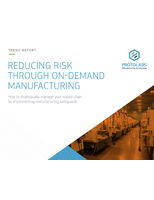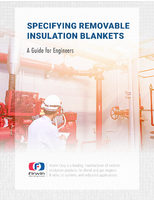Three-Stage Aerospace Filtration System delivers HEPA efficiency.
Press Release Summary:
Designed for HEPA-required paint booth exhaust systems using chromate formulations, HEPA-XFP™Ã‚ fits into standard 3-stage filtration frames without requiring HEPA framework. First stage uses CPA (multi-layered polyester) media, and second stage is ME/PT panel. Latter has air-entry layer of multi-layered, multi-density polyester and air-leaving media of ¼ in. thick, densified polyester. Constructed using 3 plies of electrostatic media, third stage consists of HEPA -XFP™ 6 Pocket Bag Filter.
Original Press Release:
The HEPA-XFP(TM): HEPA Efficiency in a 3-Stage Aerospace Filtration System
A.J. Dralle, Inc. is proud to introduce the HEPA-XFP™, an innovative and cost-saving 3-stage aerospace filtration system specifically designed for HEPA required paint booth exhaust systems using chromate formulations. The HEPA-XFP™ fits into standard 3-stage filtration frames – no HEPA framework needed. The 3rd and HEPA stage combine into one filter with low initial pressure drop. Most importantly, the HEPA-XFP™ decreases or eliminates costs associated with HEPA required paint booths, including: construction, upgrading, monitoring, filter replacement, maintenance, and disposal.
James Dralle, President and CEO of A.J. Dralle, Inc. states, “As we listened to our customers’ increased concerns over HEPA level requirements on the West Coast, we knew there was a cost-effective solution. Since most states eventually adapt the environmental laws enacted on the West Coast, the HEPA level requirements could cost the industry untold millions of dollars in paint booth construction. The HEPA-XFP™ eliminates those costs.”
HEPA-XFP™ Specifications
First Stage – CPA Media
CPA is a multi-layered polyester media. The air-entry side is constructed of a mixture of lofted denier fiber. The air-leaving side is comprised of a mixture of heavier densified fiber and inkjet printed for identification and proper installation. The media weighs 1.2 ounces per square foot.
Second Stage – ME/PT Panel
The ME/PT panel is constructed of two different layers of tackified polyester media, sealed together so the tackified layers of each media touch in the center. The method of joining is with an RF heat sealer. In addition to the perimeter seal, the product must have additional sealing in the face to keep the two layers connected. Although the perimeter seals may be sewn, the center seals on the filter face must be heat-sealed.
The air-entry layer is constructed of a multi-layered, multi-density polyester with heavy, non-migrating tackifier on the air-leaving side. The air-leaving media is a heavily densified polyester, ¼” thick, tackified on air-entry side with a weight of 0.42 ounces per square foot. The air-leaving side is inkjet printed for identification and proper installation. A galvanized nine-gauge wire frame with a minimum of one cross wire will be inserted into the center of ME/PT panel, touching the tackified sides of both media. An extruded plastic frame may be used. The ME/PT has an initial pressure drop of 0.06 water gauge (w.g) at 150 feet per minute.
Third Stage – HEPA -XFP™ 6 Pocket Bag Filter
The HEPA-XFP™ 6 Pocket Bag Filter is constructed using 3 plies of electrostatic medias arranged so each ply pre-filters the media following. The first and second plies are a composite of melt blown and spun bound polyester fibers. The third ply, or air-leaving ply, is constructed of polypropylene and acrylic media. The pockets are sewn together on the perimeter and seams, forming air channels in each bag pocket. A “J” channel is inserted into each finished pocket, and individually placed into a header. The pockets are stapled and notched together and to header to insure filter integrity. The galvanized header has a ¼” foam gasket on the air-leaving side to prevent any paint bypass around the filter assembly.
HEPA-XFP™ 3-Stage System Performance Data
NESHAP Method 319 Efficiency
99.986% - 0.49-0.59 µm – KCL
99.979% - 0.31-0.37 µm - Oleic Acid
Paint Fractional Efficiency
99.98% - 0.20-0.30 µm - Deft 44-GN-72
99.99% - 0.20-0.30 µm - Deft 02-Y-040A
Paint Arrestance
99.999% Average Removal Efficiency – Deft 44-GN-72
99.997% Average Removal Efficiency – Deft 02-Y-040A
Initial Pressure Drop
0.245 @ 120 FPM
ASHRAE 52.2 Efficiency
99.989% - 0.30-1.0 µm - MERV 16
Development and Research
The HEPA-XFP™ is a research-driven product, taking more than 3 years to develop and secure the patent. Because A.J. Dralle, Inc. is dedicated to providing the best filtration systems in the industry, James Dralle and the researchers at LMS Technologies scrutinized every detail of the test results. What they discovered was astounding. Low viscosity paint fractured during paint booth exhaust filtration. Chromate and other hazardous air pollutants (HAPs) shattered into particles small enough to escape standard filtration systems. Dralle’s findings highlight a critical discrepancy between test agents and actual paint used during aerospace coating. Dralle’s research may be one of the most important developments in the aerospace painting industry to date.
While developing the HEPA-XFP™, Dralle began testing commonly used low viscosity paints on the top 3-stage filtrations systems. He discovered the paint shatter by counting the number of paint particles entering the system and comparing that amount to the number of particles exiting the system. The number of particles exiting the systems were smaller and more numerous than those entering. Somewhere in the 3-stage system, the paint was fracturing, or shattering. Depending on the paint manufacturer and paint formulation, the number of shattered particles also greatly varied, though consistently in excess of what is acceptable for test agent standards. Additionally, various manufacturers’ 3-stage systems test performance on the same paint varied dramatically.
As a research-driven innovation, the HEPA-XFP™ uncovers and meets both the present and future needs of the aerospace painting industry. All facilities who use the HEPA-XFP™ should expect to have more efficient, environmentally friendly and compliant operations. If interested in learning more, contact Jim Dralle at 815-730-0505. Tests were performed at LMS Technologies, Inc. in Bloomington, Minnesota.




